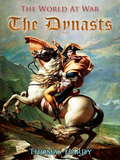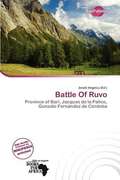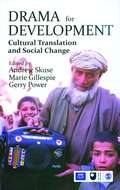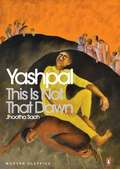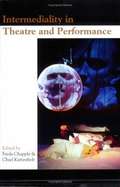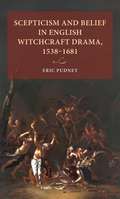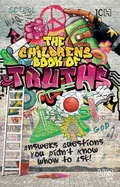- Table View
- List View
Die Macht des Kostüms: Zur textilen Verkörperung der Bühnen-Figur (Theater #148)
by Susanne StehleDie Wirkung von Bühnenkostümen in der darstellenden Kunst wird oft unterschätzt. Dabei prägen sie nicht nur das Aussehen, die Haltung und die Bewegungen der Darstellenden, sondern dienen auch als textile Verkörperung der Bühnenfigur. Susanne Stehles Untersuchung der Mode- und Theatergeschichte zeigt auf, wie sich das Kostüm über die Jahrhunderte zum komplexen Ausdrucksmittel mit eigener visueller Sprache entwickelt hat. Sie ergründet die kommunikative Wirkung von Bekleidung, deren Botschaft auf der Bühne wie im Alltag zu finden ist. Darüber hinaus verweist sie in einem Exkurs zu körperlosen Kleidungsstücken in der bildenden Kunst auf das eigenständige, künstlerische Potenzial des Kostüms.
Die Geschichte des türkisch-deutschen Theaters und Kabaretts: Vier Jahrzehnte Migrantenbühne in der Bundesrepublik (1961-2004) (Theater #149)
by Erol M. BoranDie Geschichte des türkisch-deutschen Migrant*innentheaters ist fast so alt wie die der türkischen Arbeitsmigration in die BRD. Von Beginn an befanden sich unter den Ankömmlingen nämlich auch Künstler*innen, die frühzeitig nach artistischen Ausdrucksmöglichkeiten suchten. Bald entstanden so erste Bühnenprojekte fernab der öffentlich subventionierten Theaterlandschaft, und über die Jahrzehnte entwickelte sich eine vitale Kultur, die weitgehend unbemerkt von der breiteren deutschen Öffentlichkeit stattfand. Erol M. Boran präsentiert die Vorgeschichte des zeitgenössischen postmigrantischen Theaters in Deutschland und liefert damit eine unentbehrliche Grundlage für dessen weitere Betrachtung.
Risse als materielles Schauspiel: Performative Figuren in Szenarien von Kunst und Philosophie (Theater #150)
by Holger HartungRisse schlummern oft lange unbeachtet, bis sie plötzlich in das Feld unserer Aufmerksamkeit springen. Als materielles Schauspiel bilden sie nicht nur in Kunst und Philosophie ein neues Untersuchungsfeld, sondern auch in der Theaterwissenschaft. Der Band nimmt die Verwandlungen von Rissfiguren in Texten Martin Heideggers und Jacques Derridas als Ausgangspunkt und stellt diese in den Spiegel einer Kulturgeschichte vielfältiger Rissdarstellungen. Fünf künstlerische Arbeiten unterstreichen exemplarisch die tiefgehende Affinität von Rissfiguren und theatralen Szenarien und zeigen, wie sich diese durch Themen wie kollektive Traumata, Globalität, Migration bis hin zu Ökologie immer wieder aktualisiert.
Theaterwissenschaft postkolonial, intermedial, neoinstitutionell: Christopher Balme in der Re-Lektüre (Theater #152)
by Ulf Otto David Roesner Berenika Szymanski-DüllWas kann eine Re-Lektüre ausgewählter Schriften von Christopher Balme zu einer Standortbestimmung der Theaterwissenschaften beitragen? Die Beiträger*innen stützen sich auf wichtige Impulse des renommierten Theaterwissenschaftlers und stellen vor allem Fragen der (globalen) Theaterhistoriografie sowie postkoloniale Ansätze der Aufführungsanalyse in den Vordergrund. Sie diskutieren Begriffe der Öffentlichkeit und der Institutionalisierung von Theater, vertiefen Aspekte der Medialität und Intermedialität des Theaters und hinterfragen seine »Legitimationsmythen«. Somit ergibt sich ein facettenreicher Einblick in zentrale Diskurse über das Theater - und ein Anstoß zu interdisziplinären Debatten.
Crip-queere Körper: Eine kritische Phänomenologie des Theaters (Theater #154)
by Mirjam KreuserWie steht es um die crip-queere Sichtbarkeit auf der Theaterbühne? In der Beschäftigung mit Performances von behinderten und queeren Künstler*innen befragt Mirjam Kreuser die Theaterwissenschaft im Allgemeinen und die phänomenologische Aufführungsanalyse im Besonderen zu ihrer normativen Orientierung. Die Analyse der Performance-Reihe Criptonite (Konzept: Nina Mühlemann, Edwin Ramirez) beschäftigt sich nicht nur mit dem sogenannten cripping und queering als ästhetische, sondern auch als wissenschaftliche Praxis. Das Ergebnis ist ein Vorschlag hin zu einem Entwurf von Kompliz*innenschaft in künstlerischer und akademischer Praxis.
Theater der Distribution: Künstlerische und kulturpolitische Konzeptionen von Gastspielhäusern in der deutschen Theaterlandschaft (Theater #155)
by Silvia StolzGastspieltheater sind eine Besonderheit in der deutschen Theaterlandschaft: Mit Abstand sind sie die häufigste institutionalisierte und distribuierte Theaterform, doch bekannt ist über sie nur wenig. Jenseits der Metropolen ermöglichen Gastspieltheater auf vielfältigste Weise Teilhabe. Erstmalig widmet sich Silvia Stolz umfassend dem Modell der Gastspieltheater. Sie definiert deren Erscheinungsform und bündelt Erkenntnisse um Theaterarbeit, Darstellende Künste und Strategien der Akteur*innen aus Kulturarbeit sowie Kulturpolitik. Ausgehend von Dokumentenanalysen und Expert*inneninterviews erschließen sich so neue Erkenntnisse für die Reform und Transformation der krisenhaften Theaterlandschaft: Das konzeptbasierte, kulturpolitische Programm »Theater der Distribution« soll mehr Theater für mehr Menschen ermöglichen.
Performance und Irritation: Theaterpädagogik als Handlungswissenschaft (Theater #156)
by Alina Paula GregorWie kann ein anderer Theaterunterricht aussehen? Welche neuen Möglichkeitsräume eröffnen sich, wenn die Sicht der Akteur*innen mit in den Unterricht einfließt? Alina Paula Gregor stellt die Theaterpädagogik als eine Handlungswissenschaft vor und setzt sich spielerisch-experimentell mit Performancekunst und der Bedeutung von Irritationsmomenten auseinander. Durch ein künstlerisch orientiertes Vermittlungskonzept und praxeologische Forschung legt sie dar, wie zeitgenössische Theater- und Performancearbeit als Impulsgeber über vielfältige Irritationsmomente wirken kann - und somit zur Gestaltung alternativer Unterrichtsmodelle anregt.
The Making of Modern Subjects: Public Discourses on Korean Female Spectators in the Early Twentieth Century (Gender, Diversity, and Culture in History and Politics #3)
by Sung Un GangIn the early 20th century, Korean women began to manifest themselves in the public sphere. Sung Un Gang explores how the women's gaze was reimagined in public discourse as they attended plays and movies, delving into the complex negotiation process surrounding women's public presence. In this first extensive study of Korean female spectators in the colonial era, he analyzes newspapers, magazines, fictions, and images, arguing that public discourse aimed to mold them into a male-driven and top-down modernization project. Through a meticulous examination of historical sources, this study reconceptualizes colonial Korean female spectators as diverse, active agents with their own politics who played a crucial role in shaping colonial publicness.
QueerBeograd Cabaret: A Shared Space between Queer, Anti-Facism and No Borders Politics (Theater #158)
by Ivana MarjanovicThe clandestine festival QueerBeograd created spaces of critique and transformation in order to foster a politics of interconnectedness. Ivana Marjanovi explores the festival's transnational activist cabaret between 2006 and 2008, which was devised, directed and produced by Jet Moon, a founding member of the QueerBeograd collective. This pioneering study demonstrates how the process of staging QueerBeograd Cabaret created a shared space between queer, anti-fascism and No Borders politics, contributing to the advancement of the intersectionality perspective beyond identity. The study thus investigates historical genealogies of gender and political difference in the former and post-Yugoslav space, bringing these into relation with global social and art movements.
Theaterproben und Interaktion: Sprech- und theaterwissenschaftliche Perspektiven (Theater #159)
by Anna WesselWie werden künstlerische Ideen von Regie und Schauspieler*innen in Theaterproben interaktiv entwickelt, vermittelt und ausgehandelt? Anna Wessel betrachtet Probeninteraktionen aus sprechwissenschaftlicher Perspektive und kombiniert diese mit theaterwissenschaftlichen und linguistischen Aspekten. Dabei stellt sie die Besprechungsphasen von Theaterproben in den Fokus und zeigt auf, welche interaktiven Probenpraktiken zum Einsatz kommen, wie mit ihnen Instruktionen der Regie gestaltet werden und wie die Schauspieler*innen darauf sprachlich und spielend reagieren. Die Erkenntnisse liefern eine neue Perspektive auf interaktive Prozesse theatraler Probenarbeit - in Theorie und Praxis.
Ibsen at the Theatrical Crossroads of Europe: A Performance History of Henrik Ibsen's Plays on the Romanian Stages, 1894-1947 (Theater #160)
by Gianina DrutaWhile Ibsen's plays were seldom performed in Romania in the first half of the 20th century, historical sources highlight his strong impact on the national theatre practice. To address this contradiction, Gianina Druta approaches the reception of Ibsen in the Romanian theatre in the period 1894-1947, combining Digital Humanities and theatre historiography. This investigation of the European theatre culture and the way in which the foreign acting and staging traditions influenced the Romanian Ibsenites provides new insights into mechanisms of aesthetic transmission. Thus, this study presents a European theatre landscape whose unpredictability and uniqueness cannot be confined to essentialist interpretations.
Die dunkle Seite des Spiels: Theater zwischen Spiel, Wirklichkeit und Fiktion (Theater #161)
by Gunter LöselSpiel und Theater sind vielfältig verbunden, aber solange der Spielbegriff mit Harmlosigkeit assoziiert ist, nimmt er dem Theater Schärfe und Wirksamkeit. Gunter Lösel fragt deshalb nach einer Begriffserweiterung, die auch die dunkle Seite des Spiels umfasst. Zwischen Spiel, Wirklichkeit und Fiktion entwickelt er ein »Dreiweltenmodell des Theaters« und geht der Frage nach, warum die Spezies Mensch ein performatives Spiel entwickelt hat, in welchem sie sich negative Handlungen oder konflikthafte Situationen vor Augen führt. Durch Verbindungen zu Spieltheorie, Gaming, Philosophie, Performance-Studies und KI entsteht ein Reflexionsraum, der so den Widerspruch zwischen Harmlosigkeit des Spiels und Wirkungsmacht des Theaters auflöst.
Bühne und Möglichkeitsraum: Franz Lehárs »Das Land des Lächelns« am Aalto-Theater Essen, 2019 (Theater #163)
by Lukas Kretschmer»Es könnte alles auch ganz anders sein.« Vom Entwurf und Konzept bis zur Realisierung eines Bühnenbildes ergeben sich unterschiedliche Modellierungen von Möglichkeiten. Lukas Kretschmer dokumentiert den bühnenbildnerischen Entwurfsprozess zu Franz Lehárs Operette »Das Land des Lächelns« am Aalto-Theater Essen (2019), umgesetzt als künstlerische Forschung. Dabei ist der konkrete Bühnenraum des Theaters sowohl als Entscheidungsraum wie auch - zusammen mit dem Bühnenbildentwurf - als Teil eines Möglichkeitsraums zentrales Element der künstlerisch-forschenden Praxis. Am Beispiel des explorativen Einzelfalls wird deutlich, wie ein solcher Möglichkeitsraum als Ausdruck von Konzept und Wahrnehmung entwickelt und erfahren werden kann.
Komplexität auf der Bühne: Zur Dramaturgie der Geschichtenverflechtung in zeitgenössischen Theatertexten (Theater #164)
by Ute ScharfenbergWie kann das Theater unsere heutigen opaken Wirklichkeitsverhältnisse vermitteln? Und wie können Bühnenaktionen Vorstellungen von Zusammenhang und Sinn mobilisieren? Ute Scharfenberg analysiert erstmals zeitgenössische Theatertexte, die mit außerordentlich hohen Komplexitätsgraden der Darstellung experimentieren. Die komplizierten »Verflechtungsfabeln« bringen Figuren und Ereignisse in oft überraschende Korrespondenzen und fordern ein kritisch-assoziatives Imaginieren und deutendes Interpretieren heraus. Ihre neuartigen Techniken verleihen der Darstellungs- wie auch der Zuschaukunst eine eminente Produktivität.
Theater, Terror, Tod: Das Künstlerdrama von Christoph Schlingensief (Theater #166)
by Giovanna-Beatrice CarlessoChristoph Schlingensiefs autoreferenzielles Theater verhandelt Kunst- und Künstlerdiskurse im Kontext avantgardistischer Theorie und Praxis. In detaillierten Text- und Aufführungsanalysen nimmt Giovanna-Beatrice Carlesso zwei der komplexesten und anspielungsreichsten Inszenierungen des Autor-Regisseurs in den Blick, um ein dichtes Netz aus intermedialen Selbst- und Fremdzitaten im Nexus von Kunst, Terror und Tod zu entwirren. Dabei beleuchtet sie erstmals die longue durée des Künstlerdramas und erforscht dessen Weiterentwicklung durch Schlingensief in Zeiten der Postdramatik.
Zwischen Provinz und Staatstheater: Die Institution des Stadttheaters am Beispiel der Augsburger Bühne zwischen 1877 und 2018 (Theater #167)
by Christine Holl-EnzlerBühnen unter der Trägerschaft einer Stadt bilden die überwiegende Grundlage der Theaterstätten im deutschsprachigen Raum. Am Beispiel des Theaters in Augsburg widmet sich Christine Holl-Enzler erstmals einer umfassenden Erörterung der Institution des Stadttheaters. Gleichzeitig geht sie der Frage nach, ob das Stadttheater als Provinzbühne verstanden wird und nimmt außerdem dessen kulturelle Bedeutung für die Stadtgesellschaft in den Blick. Durch das spezielle Verständnis, das Theater als Institution zu begreifen, bieten sich neue Erkenntnisse für Bühnen in der Provinz, denen der Sprung in den Rang eines Staatstheaters gelingen kann.
The Dynasts
by Thomas Hardy"The Dynasts" is an English-language drama in verse by Thomas Hardy. Hardy himself described this work as "an epic-drama of the war with Napoleon, in three parts, nineteen acts and one hundred and thirty scenes". Not counting the Forescene and the Afterscene, the exact total number of scenes is 131. The three parts were published in 1904, 1906 and 1908. Because of the ambition and scale of the work, Hardy acknowledged that The Dynasts was not a work that could be conventionally staged in the theatre, and described the work as "the longest English drama in existence". Scholars have noted that Hardy remembered war stories of the veterans of the Napoleonic wars in his youth, and used them as partial inspiration for writing The Dynasts many years later in his own old age. In addition, Hardy was a distant relative of Captain Thomas Hardy, who had served with Admiral Horatio Nelson at Trafalgar. Hardy consulted a number of histories and also visited Waterloo, Belgium, as part of his research. George Orwell wrote that Hardy had "set free his genius" by writing this drama and thought its main appeal was "in the grandiose and rather evil vision of armies marching and counter-marching through the mists, and men dying by hundreds of thousands in the Russian snows, and all for absolutely nothing."
Hijas del horror : Rocío Silva Santisteban y Regina José Galindo : mujer, testimonio y violencia en la poesía y la performance
by Bethsabé Huamán AndíaIndia's Foreign Policy Challenge and Strategy: भारत की विदेश नीति चुनौती और रणनीति
by Rajiv Sikri Chinmay Dharkhanपुस्तक एक रणनीतिक और नीति-उन्मुख दृष्टिकोण से भारत की वर्तमान और बढ़ती विदेशी नीति चुनौतियों की जांच करती है। यह देश के विदेश नीति निर्माण को निर्धारित करने वाले दीर्घकालिक कारकों और रुझानों का विश्लेषण करता है। यदि यह जटिल और तेजी से विकसित होने वाली 21 वीं सदी की दुनिया में एक प्रमुख खिलाड़ी बनना है, तो लेखक भारत के दृष्टिकोण का पुन: मूल्यांकन करने का आग्रह करता है।
Drama For Development (PDF): Cultural Translation And Social Change
by Marie Gillespie Andrew Skuse Gerry PowerThis Is Not That Dawn Jhootha Sach
by Yashpal Translated from the Hindi AnandJhootha Sach is arguably the most outstanding piece of Hindi literature written about the Partition. Reviving life in Lahore as it was before 1947, the book opens on a nostalgic note, with vivid descriptions of the people that lived in the city’s streets and lanes like Bhola Pandhe Ki Gali. Tara, who wanted an education above marriage; Puri, whose ideology and principles often came in the way of his impoverished circumstances; Asad, who was ready to sacrifice his love for the sake of communal harmony. Their lives—and those of other memorable characters—are forever altered as the carnage that ensues on the eve of Independence shatters the beauty and peace of the land, killing millions of Hindus and Muslims, and forcing others to leave their homes forever. Published in English translation for the first time, Yashpal’s controversial novel is a politically charged, powerful tale of human suffering.
Intermediality In Theatre And Performance (PDF)
by Freda Chapple Chiel Kattenbelt"Intermediality": the incorporation of digital technology into theatre practice, and the presence of film, television and digital media in contemporary theatre is a significant feature of twentieth-century performance. Presented here for the first time is a major collection of essays, written by the "Theatre and Intermediality Research Group" of the" International Federation for Theatre Research," which assesses" intermediality in theatre and performance. " The book draws on the history of ideas to present a concept of intermediality as an" integration of thoughts and medial processes," and it locates intermediality at the" inter-sections situated in-between" the performers, the observers and the confluence of media, medial spaces and art forms involved in performance at a particular moment in time. Referencing examples from contemporary theatre, cinema, television, opera, dance and puppet theatre, the book puts forward a thesis that the intermedial is a space where the boundaries soften and we are" in-between and within a mixing of space, media and realities, with theatre providing the staging space for intermediality. " The book places theatre and" performance" at the heart of the 'new media' debate and will be of keen interest to students, with clear relevance to undergraduates and post-graduates in Theatre Studies and Film and Media Studies, as well as the theatre research community.
Scepticism and belief in English witchcraft drama, 1538–1681 (Lund University Press)
by Eric PudneyWinner of the 2019 Warburg Prize from the Royal Swedish Academy of Letters, History and Antiquities for an outstanding work of literary history This is a study of the representation of witches in early modern English drama, organised around the themes of scepticism and belief. It covers the entire early modern period, including the Restoration, and pays particular attention to three plays in which witchcraft is central: The Witch of Edmonton (1621), The Late Lancashire Witches (1634) and The Lancashire Witches (1681). Always a controversial issue, witchcraft has traditionally been seen in terms of a debate between ‘sceptics’ and ‘believers’. This book argues instead that, while the concepts of scepticism and belief are central to an understanding of early modern witchcraft, they are more fruitfully understood not as static and mutually exclusive positions within the witchcraft debate, but as rhetorical tools used by both sides.
Scepticism and belief in English witchcraft drama, 1538–1681 (Lund University Press)
by Eric PudneyWinner of the 2019 Warburg Prize from the Royal Swedish Academy of Letters, History and Antiquities for an outstanding work of literary historyThis is a study of the representation of witches in early modern English drama, organised around the themes of scepticism and belief. It covers the entire early modern period, including the Restoration, and pays particular attention to three plays in which witchcraft is central: The Witch of Edmonton (1621), The Late Lancashire Witches (1634) and The Lancashire Witches (1681). Always a controversial issue, witchcraft has traditionally been seen in terms of a debate between ‘sceptics’ and ‘believers’. This book argues instead that, while the concepts of scepticism and belief are central to an understanding of early modern witchcraft, they are more fruitfully understood not as static and mutually exclusive positions within the witchcraft debate, but as rhetorical tools used by both sides.
THE CHILDREN’S BOOK OF TRUTHS
by VariousWhy do people fight? What’s the use of education? Is India rich or poor? Why are stories important? Can anyone be a leader? Is science only about exams? Will planting trees save the earth? Growing up throws up a lot of questions – about people, events and the world around us. Sometimes the answers are in simple black and white, wrong and right, but mostly they are not. In this book, ten truth-explorers and idea-shapers share with you their thought-provoking views on important topics close to your heart and mind. Drawing on their experiences, they help you see many different sides of a question and arrive at the most important truth – your own conclusion, your own interpretation, your own answer. Subroto Bagchi on Leadership Shaheen Mistri on Education Vivek Menon on Nature Meeta Kumar on the Economy Manjula Padmanabhan on Gender Bias Omair Ahmad on Conflict Bibek Debroy on God and Religion Roopa Pai on Stories Hartosh Singh Bal on Science and Maths Kapil Dev on Sports









